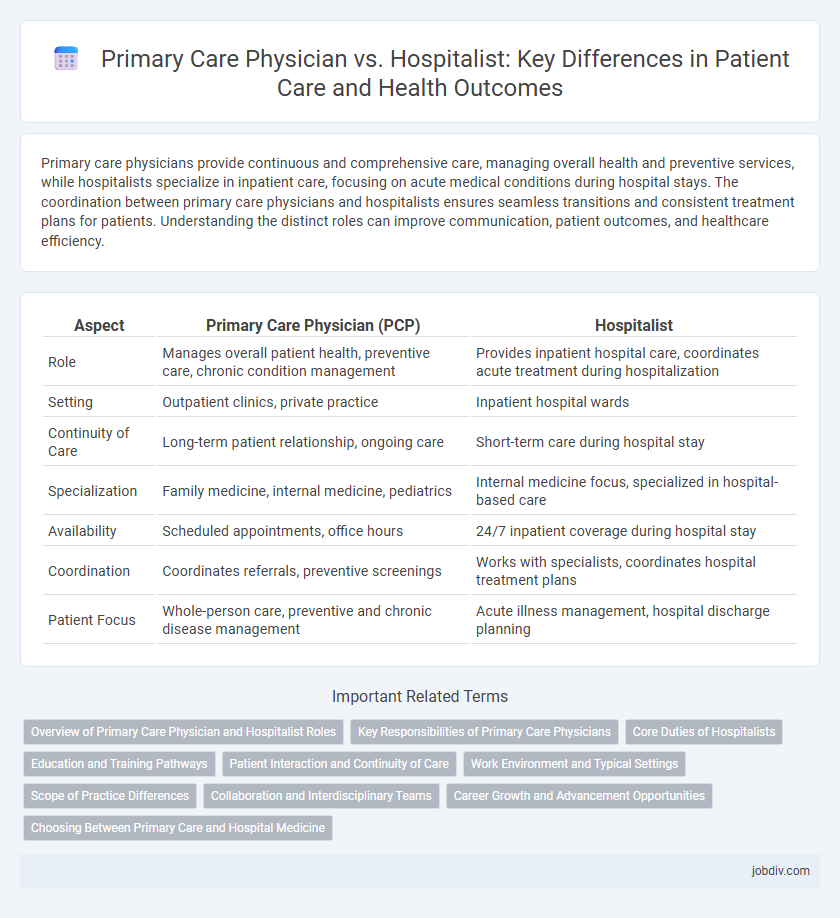Primary care physicians provide continuous and comprehensive care, managing overall health and preventive services, while hospitalists specialize in inpatient care, focusing on acute medical conditions during hospital stays. The coordination between primary care physicians and hospitalists ensures seamless transitions and consistent treatment plans for patients. Understanding the distinct roles can improve communication, patient outcomes, and healthcare efficiency.
Table of Comparison
| Aspect | Primary Care Physician (PCP) | Hospitalist |
|---|---|---|
| Role | Manages overall patient health, preventive care, chronic condition management | Provides inpatient hospital care, coordinates acute treatment during hospitalization |
| Setting | Outpatient clinics, private practice | Inpatient hospital wards |
| Continuity of Care | Long-term patient relationship, ongoing care | Short-term care during hospital stay |
| Specialization | Family medicine, internal medicine, pediatrics | Internal medicine focus, specialized in hospital-based care |
| Availability | Scheduled appointments, office hours | 24/7 inpatient coverage during hospital stay |
| Coordination | Coordinates referrals, preventive screenings | Works with specialists, coordinates hospital treatment plans |
| Patient Focus | Whole-person care, preventive and chronic disease management | Acute illness management, hospital discharge planning |
Overview of Primary Care Physician and Hospitalist Roles
Primary Care Physicians (PCPs) provide continuous, comprehensive healthcare, managing overall patient wellness, preventive care, and chronic conditions. Hospitalists specialize in inpatient care, coordinating treatment during hospital stays to ensure efficient recovery and transition. Both roles are essential for comprehensive healthcare delivery, with PCPs focusing on long-term health management and hospitalists concentrating on acute medical interventions.
Key Responsibilities of Primary Care Physicians
Primary care physicians manage comprehensive patient care, including preventive services, chronic disease management, and routine health screenings. They build long-term relationships with patients to coordinate care and refer to specialists when necessary. These physicians play a crucial role in maintaining overall health and early detection of medical conditions.
Core Duties of Hospitalists
Hospitalists specialize in managing inpatient care within hospitals, focusing on coordinating treatment plans, conducting daily patient evaluations, and facilitating communication among specialists to ensure seamless hospital stays. Their core duties include monitoring acute conditions, ordering diagnostic tests, and adjusting therapies based on real-time patient responses. Unlike primary care physicians who provide comprehensive outpatient care, hospitalists prioritize timely interventions and discharge planning to optimize recovery and reduce hospital readmissions.
Education and Training Pathways
Primary Care Physicians complete medical school followed by a three-year residency in family medicine, internal medicine, or pediatrics, emphasizing long-term patient care and preventive medicine. Hospitalists undergo similar foundational training but often pursue additional specialized hospital-based training or fellowships to manage acute inpatient conditions efficiently. Both pathways require board certification, with primary care focusing on outpatient continuity and hospitalists dedicated to inpatient care management.
Patient Interaction and Continuity of Care
Primary care physicians provide continuous, long-term care by managing overall health and coordinating treatments, fostering strong patient relationships through regular visits. Hospitalists focus on acute inpatient care, offering expertise during hospital stays but often lack ongoing interaction post-discharge. Continuity of care is stronger with primary care physicians due to consistent monitoring and personalized management, while hospitalists excel in immediate, specialized interventions during critical illness.
Work Environment and Typical Settings
Primary Care Physicians typically work in outpatient clinics, private practices, or community health centers, providing ongoing care and preventive services to patients in familiar settings. Hospitalists operate exclusively within hospital environments, managing inpatient care, coordinating with specialists, and addressing acute medical conditions during hospital stays. The work environment for hospitalists is fast-paced and hospital-centric, whereas primary care physicians enjoy long-term patient relationships outside hospital walls.
Scope of Practice Differences
Primary care physicians provide continuous, comprehensive care emphasizing disease prevention, health maintenance, and management of chronic conditions across all ages. Hospitalists specialize in inpatient care, managing acute medical issues and coordinating treatment during hospital stays without long-term patient follow-up. The primary care scope covers outpatient health services, while hospitalists focus exclusively on the complexities of inpatient diagnosis, treatment, and discharge planning.
Collaboration and Interdisciplinary Teams
Effective collaboration between Primary Care Physicians (PCPs) and hospitalists enhances patient outcomes by ensuring seamless communication and continuity of care during hospital stays. Interdisciplinary teams that include PCPs, hospitalists, nurses, and specialists facilitate coordinated treatment plans and timely discharge processes. Leveraging electronic health records (EHRs) and regular case conferences strengthens this partnership, reducing readmission rates and promoting comprehensive patient management.
Career Growth and Advancement Opportunities
Primary care physicians experience career growth through long-term patient relationships, diverse clinical skills, and opportunities in preventive care, chronic disease management, and community health leadership. Hospitalists advance by gaining specialized inpatient expertise, leading quality improvement initiatives, and taking on administrative roles within hospital systems. Both career paths offer distinct trajectories, with primary care focusing on continuity of care and hospitals emphasizing acute care management and system-based leadership.
Choosing Between Primary Care and Hospital Medicine
Choosing between a primary care physician and a hospitalist depends on the continuity and setting of care needed. Primary care physicians manage overall health, chronic conditions, and preventive services in outpatient settings, ensuring long-term patient relationships. Hospitalists specialize in inpatient care, coordinating treatment during hospital stays to optimize acute care outcomes and facilitate communication among specialists.
Primary Care Physician vs Hospitalist Infographic

 jobdiv.com
jobdiv.com